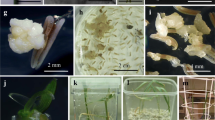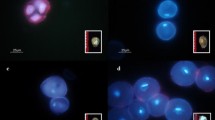Abstract
The effect of culture of anthers at 35 °C for one to four days prior to culture at 25 °C in darkness, genotype, anther orientation on callus induction and shoot regeneration in anther culture of flax was investigated. The influence of type and concentrations of cytokinins in the regeneration medium on shoot regeneration was also investigated. The results suggested that culture of anthers at 35 °C prior to continuous culture at 25 °C in darkness did not significantly improve the percentage of anthers producing calli. However, culture of anthers at 35 °C for one day significantly increased the overall efficiency of regeneration compared to no culture temperature treatment. Genotypic effects were significant for the percentage of anthers producing calli and the overall efficiency of regeneration. Anther orientation showed no significant differences. The regeneration medium containing 4.5 μM zeatin had significantly higher percentage of calli forming shoots than the same basal medium containing 0.01 μM TDZ. The importance of these findings for flax breeding was discussed.
Similar content being viewed by others
References
Anonymous, 1996. Growing flax: production, management & diagnostic guide. Flax Council of Canada. 3rd edition.
Bergmann, R. & W. Friedt, 1996. Haploidy and related biotechnological methods in linseed (Linum usitatissimum L.). In: S.M. Jain, S.K. Sopory & R.E. Veilleux (Eds). In vitro haploid production in higher plants, vol. 5, pp. 1–16. Kluwer Acad Publ., Dordecht.
Bickert, C., R. Bergmann, A. Büchsenschutz-Nothdurft & W. Friedt, 1993. Einsatz der antheren-und mikrosporenkultur in der züchtung von ollein im hinblick auf eine verbesserung von fettgehalt und-qualität. Arbeitstagung der Arbeitsgemeinschaft der Saatzuchtleiter 44: 115–121.
Bretagne, B., M. Chupeau, Y. Chupeau & G. Fouilloux, 1994. Improved flax regeneration from hypocotyls using thidiazuron as cytokinin source. Plant Cell Reports 14: 120–124.
Browne, R.D., C.G. Davidson, T.A. Steeves & D.I. Dunstan, 1997. Effects of ortet age onadventitious rooting of jack pine (Pinus banksiana) long-shoot cuttings. Can J For Res 27: 91–96.
Dribnenki, J.C.P., A.G. Green & G.N. Atlin, 1996. Linora™ 989 low linolenic flax. Can J Plant Sci 76: 329–331.
Dunwell, J.M., M. Cornish, A.G.L. Decourcel & J.E. Middlefell-Williams 1983. Induction and growth of 'microspore-derived' embryos of Brassica napus ssp. oleifera. J Exp Bot 34: 1768–1778.
Dunwell, J.M., M. Cornish & A.G.L. Decourcel, 1985. Influence of genotype, plant growth temperature and anther culture temperature on microspore embryo production in Brassica napus ssp. oleifera. J Exp Bot 36: 679–689.
Foroughi-Wehr, B. & G. Wenzel, 1993. Andro-and parthenogenesis. In: M.D. Hayward, N.O. Bosemark & I. Romagosa (Eds). Plant Breeding: Principles and prospects, pp. 261–277. Chapman & Hall, London.
Friedt, W., C. Bickert & H. Schaub, 1995. In vitro breeding of high-linolenic, doubled-haploid lines of linseed (Linum usitatissimum L.) via androgenesis. Plant Breeding 114: 322–326.
Gamborg, O.L., R.A. Miller & K. Ojima, 1968. Nutrient requirements of suspension cultures of soybean root cells. Experimental Cell Research 50: 151–158.
Hunter, C.P., 1985. The effect of anther orientation on the production of microspore-derived embryoids and plants of Hordeum vulgare cv Sabarlis. Plant Cell Reports 4: 267–268.
Keller, W.A. & K.C. Armstrong, 1978. High frequency production of microspore derived plantsform Brassica napus anther cultures. Z Pflanzenzucht 80: 100–108.
Keller, W.A. & K.C. Armstrong, 1979. Stimulation of embryogenesis and haploid production in Brassica campestris anther cultures by elevated temperature treatments. Theor Appl Genet 55: 65–67.
Kenaschuk, E.O. & J.A. Hoes, 1986. NorLin flax. Can J Plant Sci 66: 171–173.
Kenaschuk, E.O. & J.A. Hoes, 1986. McGregor flax. Can J Plant Sci 66: 175–176.
Kenaschuk, E.O. & K.Y. Rashid, 1994. AC McDuff flax. Can J Plant Sci 74: 815–816.
Kenaschuk, E.O., K.Y. Rashid & G.H. Gubbels, 1996. AC Emerson flax. Can J Plant Sci 76: 483–485.
Mercy, S.T. & F.J. Zapata, 1987. Position of anthers at plating and its influence on anther callusing in rice. Plant Cell Reports 6: 318–319.
Nichterlein, K.M., H. Umbach & W. Friedt, 1991. Genotypic and exogenous factors affecting shoot regeneration from anther callus of linseed (Linum usitatissimum L.). Euphytica 58: 157–164.
Nichterlein K.M. & W. Friedt, 1993. Plant regeneration from isolated microspores of linseed (Linum usitatissimum L.). Plant Cell Reports 12: 426–430.
Powell, W., E.M. Borrino & V. Goodall, 1988. The effect of anther orientation on microspore-derived plant production in barley (Hordeum vulgare L.). Euphytica 38: 159–168.
SAS/STAT User's Guide, 1989. Version 6, Fourth Edition, Volume 2. SAS Institute Inc., Cary, NC.
Shannon, P.R.M., A.E. Nicholson, J.M. Dunwell & D.R. Davies, 1985. Effect of anther orientation on microspore callus production in barley (Hordeum vulgare L.). Plant Cell Tissue Organ Cult 4: 271–280.
Sharma, K.K. & S.S. Bhojwani, 1985. Microspore embryogenesis in anther cultures of two Indian cultivars of Brassica juncea (L.) Czern. Plant Cell Tissue Organ Cult 4: 235–239.
Sopory, S.K. & S.C. Meheshwari, 1976. Development of pollen embryoids in anther culture of Datura innoxia. J Exp Bot 27: 49–57.
Sun, H. & W. Fu, 1981. Induction of pollen plants in flax (Linum usitatissimum) and preliminary observations on performance of their progenies. Acta Gent Sin 8: 369–374.
Author information
Authors and Affiliations
Rights and permissions
About this article
Cite this article
Chen, Y., Kenaschuk, E.O. & Procunier, J.D. Plant regeneration from anther culture in Canadian cultivars of flax (Linum usitatissimum L.). Euphytica 102, 183–189 (1998). https://doi.org/10.1023/A:1018321428210
Issue Date:
DOI: https://doi.org/10.1023/A:1018321428210




